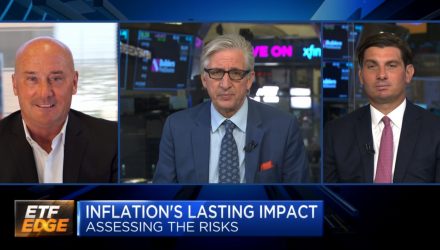Markets wobbled as fears of a one-two punch of inflation and resurging COVID continue to mount. But some sectors—and ETFs—will remain buoyant, said the hosts on the latest episode of the ETF Edge podcast.
James Davolos, portfolio manager and research analyst at Horizon Kinetics, joined Tom Lydon, CEO of ETF Trends, and host Bob Pisani to discuss Covid’s lingering effects on markets and an ETF particularly poised to benefit from inflation.
First up: This week’s market meltdown. ETFs that are selling include those holding high technology stocks, quality and momentum funds, and all-size funds. ETFs that hold work-from-home stocks, such as Zoom (ZM) and Peloton (PTON), are continuing to perform well, however.
INFL: Protect Against Inflation With Royalty Companies
Davolos believes that in the long-term, markets will turn to reflation, and ultimately inflation. His firm has created an ETF to capture that: the Horizon Kinetics Inflation Beneficiaries ETF (INFL). INFL pinpoints royalty companies – that is, hard assets businesses that are capital-light, and lays them within a valuation framework.
Examples of companies included in the fund’s portfolio are Texas Pacific Land (TPL) and Wheaton Precious Metals (WPM).
“The number one fear that advisors have today is inflation, followed closely by high stock valuations, so they’re gearing up to protect their clients from inflation and looking at these types of options in commodity ETFs,” said Lydon.
Commodities have been hot most of the year, and commodities ETFs such as Invesco’s Optimum Yield Diversified Commodity Strategy No K-1 ETF (PDBC), which holds futures contracts, have been a great buy so far this year.
Gold, Lydon points out, is typically a “second-half player” when it comes to inflationary times. As inflation really kicks in, investors should look for prices to start ticking up.
Lydon went on to discuss the 10-Yr Treasury yield, which is at 1.3%, and how people are pivoting to shorter-duration bonds.
ETFs overall are seeing a shift towards active management and alternative income strategies, such as JP Morgan Equity Premium Income (JEPI), which use options overlay strategies for fixed income.
The first half of the year has seen money flow several ways into the ETF space: into passive indexed ETFs, more actively managed ETFs being created, as well as the conversion from mutual funds to ETFs—all culminating in potentially a record year for flows to ETFs.
Learn More From Tom Lydon’s Appearance On ETF Edge:
For more market trends, visit ETF Trends.
